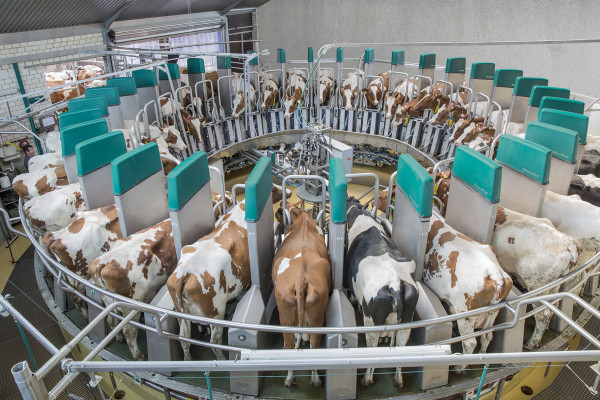
One of the busiest dairy exhibits at World Ag Expo gave an up-close look at what is the inevitable future for many large herd farms — a fully automated rotary milking parlor. The new, high-tech system can milk herds of up to 4,500 cows – and all it takes is one human.
The DairyProQ from GEA Farm Technologies is the second robotic rotary configuration to be introduced so far, but the first to provide udder prep, unit attachment, postdipping, and unit back flushing at each individual stall. This allows the platform to stay in constant motion as cows load and exit, like nonrobotic rotaries do. If you’re a large-herd dairy owner who thought robotic milking would never work for your operation, you’re exactly who GEA Farm Technologies had in mind when it created its new DairyProQ.
“This is the large-farm solution,” said Steve Pretz, vice president of large project sales for GEA Farm Technologies. “It’s the next step in automated milking.”
The five-stall section on display was like a magnet to passersby, who regularly stood three and four deep in front of it. The distinct multi-generational make-up of the audience is worth noting. Older individuals tended to look from a distance, but younger generation members tended to get up close and inspect the mechanics and the process. The new DairyProQ targets U.S. dairies ranging in size from 600 to 3,200 cows milking three times a day, or 4,500 cows at twice-daily milking. Completely automated, it can milk from 28 to 80 cows at a time with only one human on hand to monitor the process.
Company representatives said the parlors can be configured with between 28 and 80 stalls, each with its own “module” for the robotic components that can be easily removed and exchanged for maintenance if needed.
Two 40-stall parlors are already in operation in Germany. In addition, a 28-stall unit for 600 cows (3x) and a 40-stall unit for 1,200 cows (3x) are due to come on-line in Holland March 1. Three parlors have been sold in Germany and one in Holland but have yet to begin construction. The company’s goal is to sell 1,000 robotic modules in 2015.
Approximate cost of a robotic rotary parlor is three times that of a conventional one, according to Pretz. “It won’t cash-flow if you only plan on milking two hours in the morning and two hours in the evening,” he said. “You need to use it 24 hours a day.”And yet, the high cost did not come as a deterrent to everyone. In fact, I spoke to one local dairyman who is not only extremely interested, but his banker is too.
“One of these would eliminate 75 percent of my employees and 95 percent of my headaches,” he said. The global dairy milking manufacturer says its DairyProQ allows producers to increase their herd size without adding new employees. Workers once stationed on regular milking shifts can now focus on other herd management tasks.
That, in a nutshell, sums up not only the declining supply and quality situation of labor on dairy farms, but also why robotic milking at large dairies is so inevitable. Pretz hopes to see it gain acceptance in California, where herds of 1,000-plus cows are typical. Additionally, he sees robotic rotary parlors as a way to bring in new labor-saving technology in the Golden State, where remodeling, not building a new dairy, is more likely these days. A tough business climate and a stringent permitting process have resulted in no new dairy construction in California over the past few years.
GEA Farm Technologies hopes to have two DairyProQ units operating in North America by the end of the year – one in the U.S. and one in Canada. It already has three up and running on German dairies ranging in size from 300 to 1,200 cows.













